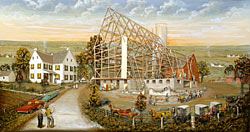Friday, December 24, 2004
Amish and Mennonite folk painting exhibit, including Emma Schrock paintings, opens Jan. 16
GOSHEN,
Ind. – They never took an art class or had dreams of their work
hanging in a gallery. But paintings made by self-taught folk painters
from Amish and conservative Mennonite communities, including well-known
folk painter Emma Schrock, will be on exhibit in the Goshen College
Library Gallery beginning Jan. 16 with a reception for the public
from 2 to 4 p.m. The exhibit will be on display until May 13.
Artists, gallery owners, critics and
others sometimes call such art “outsider” art because
it comes from artists and communities that are not involved in mainstream
commercial or academic art worlds.
“A better term for this art is
‘folk’ art, since the artists are very much ‘inside’
their own traditional, or folk, cultures. So much so, in fact, that
the subjects of their landscapes and genre paintings come directly
from their everyday experience and are done to appeal especially to
people from their close-knit communities,” said exhibit organizer
Ervin Beck, Goshen College professor emeritus of English.
As Schrock said, “I live what
I paint and I paint what I see.”
Folk artists often depict everyday reality
in a stylized manner, even if they are aiming at a kind of realism.
Although each artist has a distinctive style, usually forms are simplified,
colors are exaggerated and perspectives are flat. Those qualities
lead some observers to regard such art as “naïve”
or “primitive,” although like “outsider,”
these terms are condescending because they assume that academic art
is normative.
“I like these folk paintings because
they are unpretentious and often have an interesting non-photographic
abstraction that you don’t get in studied paintings,”
said Faye Peterson, curator of the exhibit. “It is sort of like
children’s art, you are often surprised. There is a spontaneity
about them that you can’t predict. They are easy to relate to
and there is a deep humanity about them.”

Though Amish and conservative Mennonites
do not typically revere nonfunctional art, or art for art’s
sake, they often accept paintings like those exhibited here because
they depict the local scene, they are homemade by people that they
know, and they are inexpensive to buy, according to Beck, a folklorist.
Two noted Amish exceptions in this exhibit are Schrock, whose Old
Order Mennonite community forbids the depiction of the human form,
and Abraham Z. Peachey, who painted Mifflin County Amish landscapes
that he himself was not allowed, by his church, to hang on the walls
of his own home.
A
third of the exhibit paintings come from Schrock, who lived from 1924
to 1991 and resided near Wakarusa, Ind. She bought her first paint
canvas when she was 40 years old. Born physically handicapped, painting
became the way that Schrock earned a living, creating one piece a
day. A wheelchair made for her in childhood by her father will also
be on display.
A reverse painting on glass titled “Rock
Run Flowing Well Farm,” made by Fannie Troyer in 1930, which
depicts the home of her parents, Seth and Lizzie Troyer, near Goshen
in Clinton Township, Ind., will be on display, as well as a three-dimensional
plaster bas relief piece, “Barn-raising,” by Aaron Zook
of Lancaster County, Pa.
Leah Johnson, a Holdeman Mennonite from
Montezuma, Kan., has painted sod houses set in various Kansas regional
landscapes since 1967. She uses a self-developed, three-dimensional
sand-painting technique, which can be seen in her “Old Soddy”
painting, which will be on display.

Other artists, mostl Amish or formerly
Amish, included in the exhibit are Benuel King from Lancaster County,
Pa.; August Wickey from Berne, Ind.; Joni Hostetler from Fredericksburg,
Ohio; Anthony Yoder from Kalona, Iowa; Dan M. Yoder Jr. from Belleville,
Pa.
The exhibit content is primarily acrylic
paintings, but also includes reverse painting on glass, watercolor,
painted plaster bas relief, sand painting and paintings on a plate,
saw blade, ironing board and crockery. The artistic subjects include
scenes of homesteads, auctions, thrashings, quiltings, church and
school life, and animals.
“These folk paintings from conservative
Anabaptist communities suggest once more that the impulse toward artistic
expression is a universal one and that the love of colorful images
cannot be denied,” said Beck.
The Library Gallery, located on the
lower level of the Wilma and Harold Good Library, is open from 7:30
a.m. to 11 p.m. Monday-Thursday, 7:30 a.m. to 5 p.m. Friday, noon
to 6 p.m. Saturday and 1 to 11 p.m. Sunday.
The exhibit is sponsored by the Mennonite-Amish
Museum Committee and the Mennonite Historical Library.
Goshen College, established in 1894,
is a four-year residential Christian liberal arts college rooted in
the Anabaptist-Mennonite tradition. The college’s Christ-centered
core values – passionate learning, global citizenship, compassionate
peacemaking and servant-leadership – prepare students as leaders
for the church and world. Recognized for its unique Study-Service
Term program, Goshen has earned citations of excellence in Barron’s
Best Buys in Education, “Colleges of Distinction,”
“Making a Difference College Guide” and U.S.News &
World Report’s “America’s Best
Colleges” edition, which named Goshen a “least debt college.”
Visit https://www.goshen.edu/.
Editors:
For more information, contact News Bureau Director Jodi H. Beyeler
at (574) 535-7572 or jodihb@goshen.edu.
###
